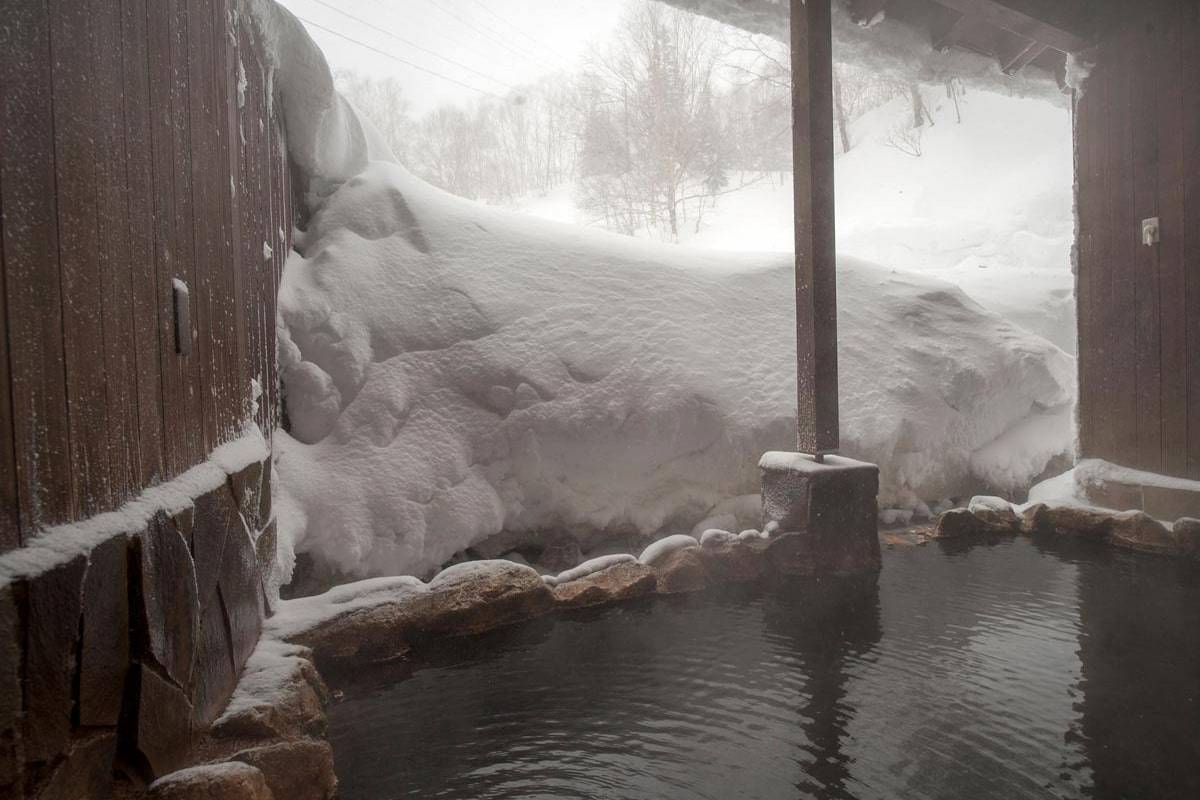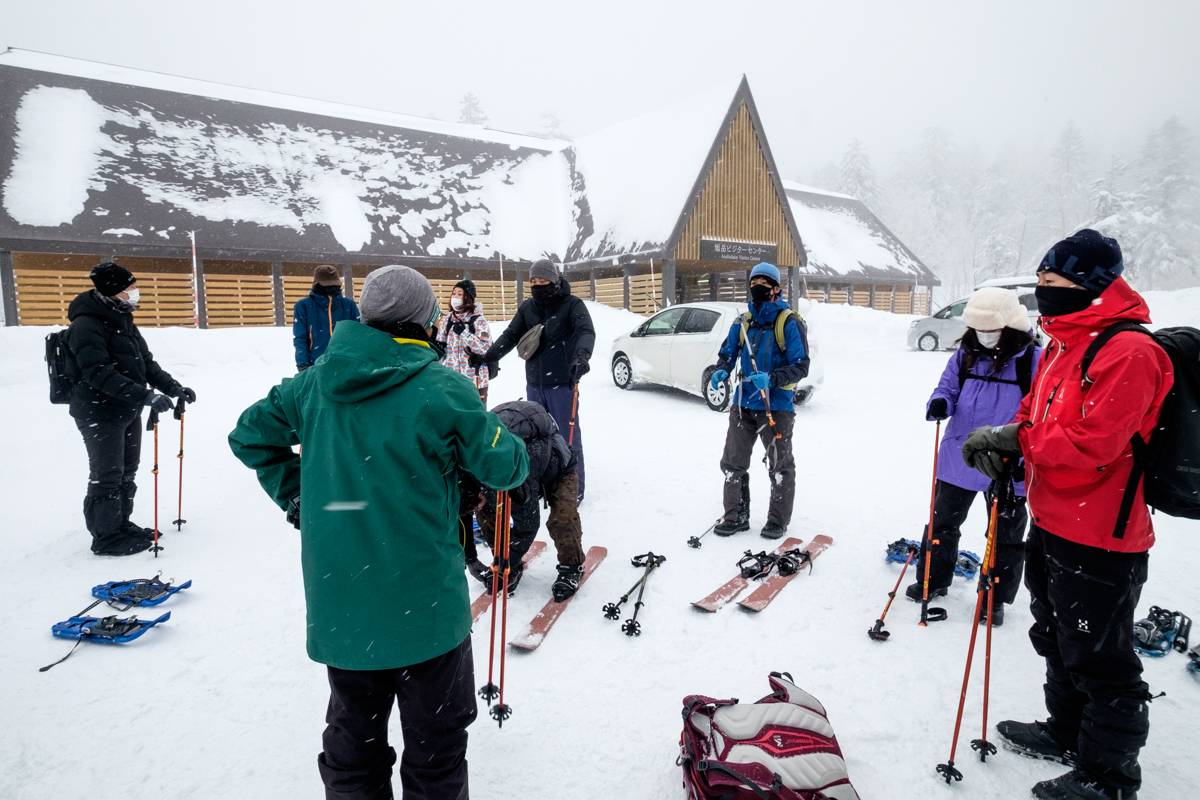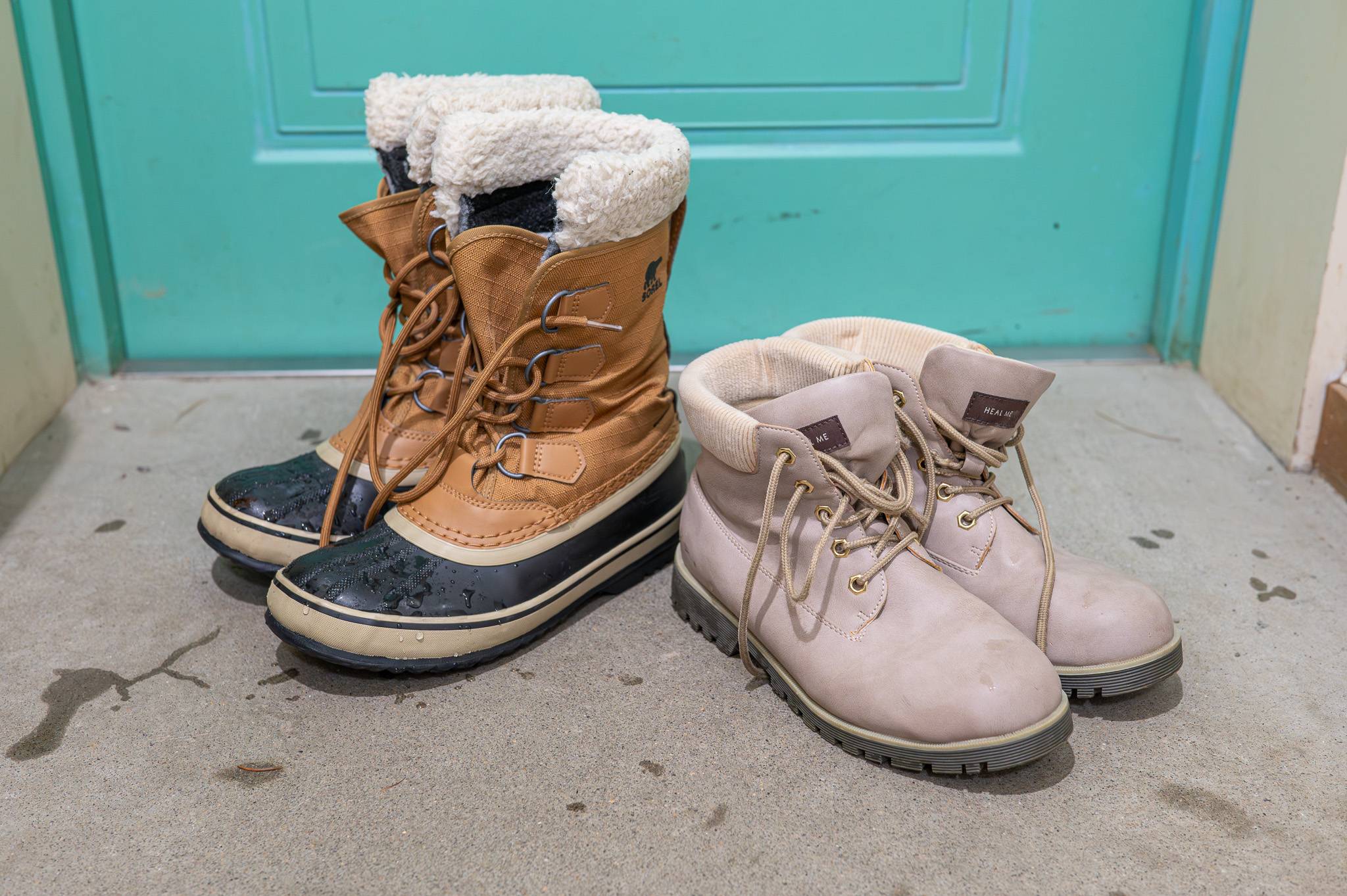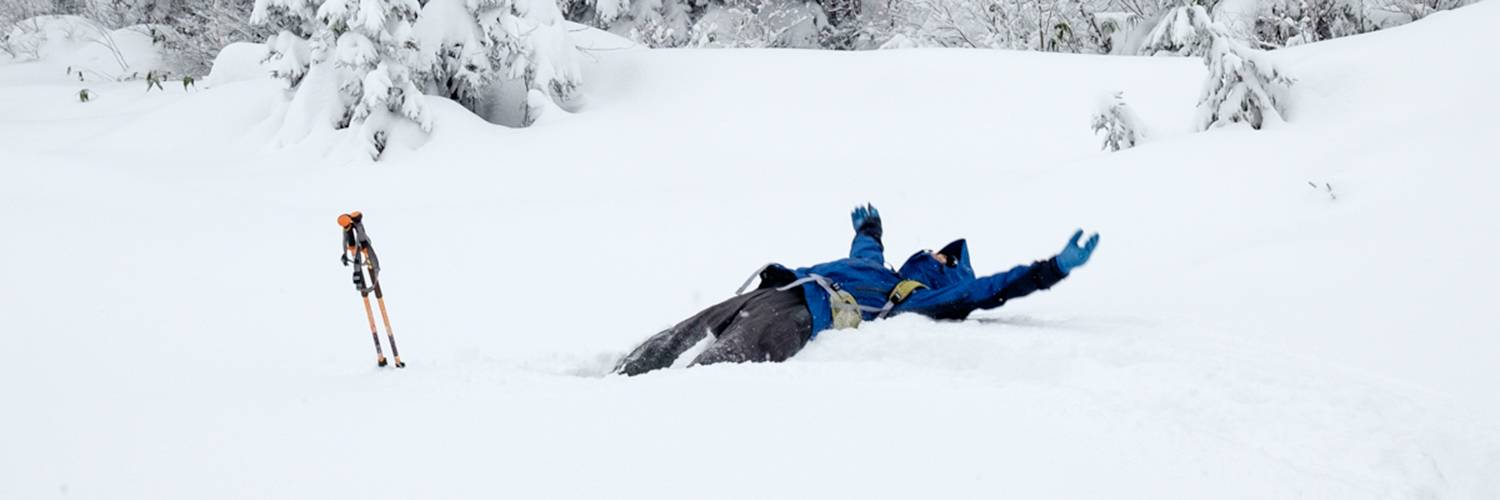Lake Mashu, its surface frozen over in several massive plates of ice. Two Steller’s sea eagles trace the frigid sky above its eastern shore. The sharp whistle of deer sounds from below, and a rush of wind from the north blows white patterns into the still air.
A Local's Guide to Snowshoeing in Hokkaido
Activity Guide
By Michael

A scene such as this is quintessential Hokkaido. And yet many winter visitors to the island, drawn to its excellent slopes for skiing and snowboarding, miss out on experiencing such magical beauty. Luckily, there is one exhilarating way to access these unforgettable sights, sealed away as they are by snow, ice, and frost. By donning a pair of snowshoes, just about anybody can traverse Hokkaido’s beautiful frozen landscapes. In this blog post, we will go over everything you will need to know about snowshoeing in Hokkaido, and what makes it such a special and timeless activity.
What is Snowshoeing?
First of all, what is snowshoeing? In a nutshell, it’s winter hiking! It allows us to reach locations otherwise inaccessible on foot. But just how, exactly? Snowshoe design can vary across different brands, but they are generally wide, flat, and lightweight platforms which you attach to your boots. What they do is distribute your weight evenly over snow, so that instead of sinking down to your chest with every step you take, you can ascend a slope, or skip across even the snowiest of fields with ease. As such, it offers a very unique blend of exhilaration and tranquility—exhilaration from traversing sublime, rugged snowscapes, tranquility from simply strolling through the silent stillness. Feel like scaling a slope at full speed, with brisk mountain wind blowing against your face? Or slowly walking through a forest to admire the sparkling diamond dust in the air, the glistening icicles hanging from the trees? Either way, snowshoeing has got you covered!

I’ve noticed that many people who have never tried snowshoeing before assume that it requires a certain level of skill to master, and feel too intimidated to give it a shot. I can assure each and every reader of this blog that this is not the case. Simply attach the snowshoes to your boots, and walk. It really is that simple! For me, that’s what makes snowshoeing so great. Not only is it easy to get the hang of, it grants you access to some of the most extraordinary sights Hokkaido has to offer. It really is the most “egalitarian” of winter activities.
The prime season for snowshoeing is roughly from late-December to late-March. That gives us about three months to explore and experience Hokkaido at its most terrific and mysterious. But what is it exactly that makes Hokkaido the best location for snowshoeing?
Hokkaido’s Special Something
Hokkaido stands out as an exceptional destination for snowshoeing primarily due to the unparalleled quality of its snow. The region’s abundant snowfall creates vast blankets of powder which, with a pair of snowshoes on hand (or rather, on foot), link us to certain areas and natural phenomena that are inaccessible during summer months. Take, for instance, the incredible fumaroles of Mt. Asahidake, spewing terrific billows of sulfuric steam into the air. These are off-limits during summer, but can easily be accessed by snowshoe during the winter season. Watching and listening to the fumaroles’ deep roar from up close, you can truly feel the immense force and power of the planet rushing up out of the mountain, something that simply can’t be experienced when observing them from afar.

One of my favorite snowshoeing destinations is the third observation deck of Lake Mashu. Although accessible by car during summer, the road leading to it closes every year once the snowy season begins. The area consequently feels very far-removed from civilisation. With a flask of hot tea, you can sit here and watch the eagles soar above, or listen to the plates of ice on the lake’s surface scrape against one another, sending unearthly noises up to the surrounding cliffs. It’s the kind of place where the distance between you and the rest of the natural world seems to completely vanish, and you begin to feel as if you are in beautiful accord with the elements.

Snowshoes have allowed access across Hokkaido’s snowfields for centuries, long before the Japanese colonized the island. The indigenous Ainu people understood many generations ago that snowshoes were the best tool for traversing the land. How many years ago did those ancient travelers gaze upon the same frozen scenes we now know and love, and experience the same sense of wonder? Walking through the woods, you cannot help but hear the echoes of that rich history resonating through the trees.

There’s no doubt that wandering through icy forests and down snowy slopes can leave you feeling a bit fatigued and famished. Fortunately, there are some excellent methods for warming up after snowshoeing in Hokkaido! Onsen, or Japanese hot springs, are everywhere. And unlike many onsen in more urban areas, a large number of these are gensen onsen, straight from the source, and thus saturated with various minerals which contain special health benefits of their own. There is simply no better way to end a snowshoeing trip than to soak in a piping hot bath, with nothing but the trickle of water and the steam rising all around to soothe you. Check out our blog post on how to enjoy onsen like a local to get up to speed on the hot spring magic.

After sufficiently warming up in a nice onsen bath, why not enjoy a big bowl of steaming-hot noodles? Miso ramen with butter and corn is a certified Hokkaido classic. Or what about kashiwa soba, hot Hokkaido-grown buckwheat noodles served with delectable chunks of chicken? If noodles aren’t your thing, then soup curry, a delicious and uniquely Hokkaido dish, might be the right choice for you! One way or another, Hokkaido’s cuisine is guaranteed to provide both a toasty and tasty conclusion to your snowshoeing excursion.
Preparing to Snowshoe
We discussed earlier that one of the greatest aspects of snowshoeing is that virtually anyone can pop a pair of snowshoes on their boots and quickly get the hang of how they work. There are however some points to consider when preparing for your snowshoeing adventure. Let’s briefly go over some of them in this section.

Let’s begin with the snowshoes themselves. Many places in Hokkaido (ropeway stations and tourism associations, for example) rent them out to visitors, sometimes for free, sometimes for a fee. However, if you’re booking a winter tour with Adventure Hokkaido, there is no need to worry about where to find them—we provide snowshoes to our guests.
But what kind of boots should you wear while snowshoeing? The kind of winter boots you might typically wear on a day out in the city, and which give you ample protection from snow and moisture there, might not be the best choice for snowshoeing out in the forest. Why? Soft boots might get damaged, even torn by snowshoe straps. And if your boots are not high enough, you will most definitely find loads of snow getting into them. The last thing you want out in the winter wilderness is cold, soggy socks! We recommend high-cut, warm, and durable winter boots. High-cut to prevent snow from getting in, warm to sufficiently insulate your feet, and durable to withstand the strain from the snowshoes’ straps and grips.

Next, let’s discuss what kind of outfit will help ensure an enjoyable snowshoeing adventure. As you most likely know, winters in Hokkaido can get extremely cold. Don’t be surprised if temperatures drop to -15°C—in the middle of the day, no less! For these kinds of conditions, the correct layering is essential.
My typical snowshoeing attire looks something like this: a long sleeve thermal, a thin down vest, another down jacket on top of that, and a thicker down outer layer to finish it off. Two layers of gloves are preferred over one, and a warm knit hat is never a bad idea. As far as socks go, I usually wear double, with the outer pair being the thickest ones in my collection. Although, if your boots are already tight, an extra pair of socks will just restrict blood flow and make your feed colder!
Remember, while snowshoeing can indeed be an exhilarating experience, there may be moments when you stop for a break to enjoy the view, with little in the way of extreme body movement. As such, your body temperature will not stay as high as if you were doing something more physically taxing, like skiing or snowboarding, and the cold can feel a tad bit more biting. If you know that you are particularly susceptible to the cold, bringing along some kairo, little warming packs that you can attach to your body, and which are sold at every convenience store in Hokkaido, would be advisable. My hands tend to get much colder than the rest of my body, and I find it quite difficult to handle certain objects like my camera or my phone with numb fingers. But by stuffing some small kairo into my gloves, I can easily avoid this problem, and take as many pictures with my camera as I please.
You can see our blog for a more detailed look on how to dress for Hokkaido’s winter.
This last point might seem rather hyper-specific, but it is crucial for snowshoe beginners. If you want to move backwards while wearing snowshoes, don’t step backward! First, rotate your body in the direction you want to go, and then move forward in that direction. Snowshoes are designed specifically for forward movement. Stepping backwards while wearing snowshoes will most likely cause them to get stuck in the snow, and for the wearer to have a regrettable tumble. Powder snow usually makes for a soft landing, but still let’s stay above the snow on our snowshoeing journey!

Ready to give it a try?
We hope that this blog post has helped make clear what it is that makes snowshoeing in Hokkaido so special. It’s at once a highly accessible activity that virtually anyone can master, as well as the prime way to access Hokkaido’s most awe-inspiring sights and locations. From frozen lakes, to snow-capped volcanoes, to mysteriously silent forests, snowshoeing enables a special kind of connection to the essence of the island. Should you choose to join one of our winter tours, our experienced guides will share with you their vast knowledge of the land, and ensure that your experience here will be fun, enlightening, and above all, unforgettable.
We can’t wait to welcome you to the wonderful world of snowshoeing in Hokkaido!
Ready to brave the cold?
Join us for a winter adventure in Hokkaido